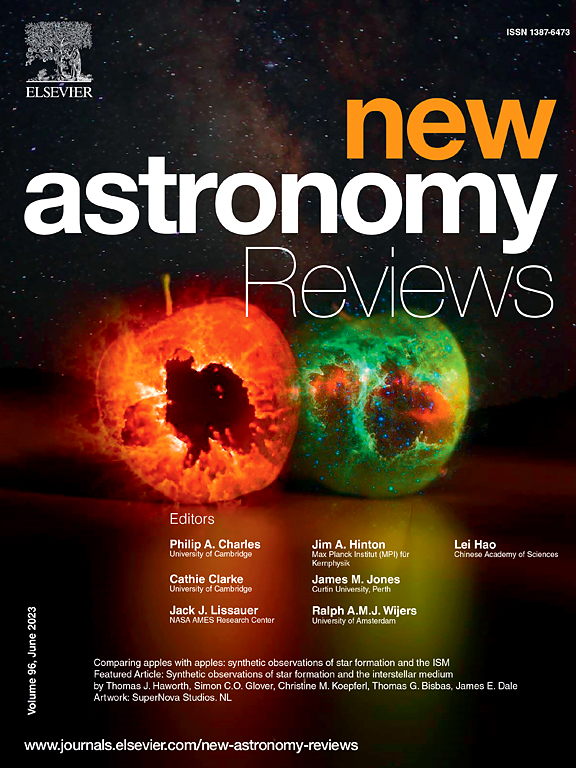盖亚时代的恒星流
IF 26.8
2区 物理与天体物理
Q1 ASTRONOMY & ASTROPHYSICS
引用次数: 0
摘要
星系形成的分层模型预测,银河系晕是由矮星系和球状星团的潮汐碎片组成的。由于长期的动态时间,来自最低质量物体的碎片在数十亿年的时间里保持着稀薄和动态冷恒星流的一致性。盖亚任务为数十亿颗恒星提供了天体测量和分光光度法,它给我们对银河系冷恒星流的看法带来了三个根本性的变化。首先,利用盖亚的数据已经发现并描述了一百多个恒星流。由于盖亚有能力在银河系中识别移动的恒星群,这是精确测量流数量的一个数量级增加。其次,盖亚的数据揭示了沿恒星流和跨恒星流的密度变化是很常见的。理论上,暗物质亚晕和重子结构被预测会形成这样的特征,但在盖亚之前,密度变化的观测证据并不确定。第三,流的运动学现在广泛可用,并且约束了流的轨道和起源。盖亚不仅直接提供了适当的运动,而且能够对适当运动的选定目标进行有效的光谱跟踪。这些发现已经将恒星流确定为银河系晕中由敏感引力示踪剂组成的密集网。我们期望在未来的十年里,我们能够绘制出银河系恒星流的完整地图,并开发出能够准确解释恒星流在银河系内演化的各种宇宙学模型的数值模型。也许最令人兴奋的是,两者之间的比较将能够揭示暗物质亚晕的存在,低于星系形成的阈值(> 106M⊙),并在小尺度上对冷暗物质范式提供最严格的测试。本文章由计算机程序翻译,如有差异,请以英文原文为准。
Stellar streams in the Gaia era
The hierarchical model of galaxy formation predicts that the Milky Way halo is populated by tidal debris of dwarf galaxies and globular clusters. Due to long dynamical times, debris from the lowest mass objects remains coherent as thin and dynamically cold stellar streams for billions of years. The Gaia mission, providing astrometry and spectrophotometry for billions of stars, has brought three fundamental changes to our view of cold stellar streams in the Milky Way. First, more than a hundred stellar streams have been discovered and characterized using Gaia data. This is an order of magnitude increase in the number of well-measured streams, thanks to Gaia’s capacity for identifying comoving groups of stars among the field Milky Way population. Second, Gaia data have revealed that density variations both along and across stellar streams are common. Dark-matter subhalos, as well as baryonic structures were theoretically predicted to form such features, but observational evidence for density variations was uncertain before Gaia. Third, stream kinematics are now widely available and have constrained the streams’ orbits and origins. Gaia has not only provided proper motions directly, but also enabled efficient spectroscopic follow-up of the proper-motion selected targets. These discoveries have established stellar streams as a dense web of sensitive gravitational tracers in the Milky Way halo. We expect the coming decade to bring a full mapping of the Galactic population of stellar streams, as well as develop numerical models that accurately explain their evolution within the Milky Way for a variety of cosmological models. Perhaps most excitingly, the comparison between the two will be able to reveal the presence of dark-matter subhalos below the threshold for galaxy formation (), and provide the most stringent test of the cold dark matter paradigm on small scales.
求助全文
通过发布文献求助,成功后即可免费获取论文全文。
去求助
来源期刊

New Astronomy Reviews
地学天文-天文与天体物理
CiteScore
18.60
自引率
1.70%
发文量
7
审稿时长
11.3 weeks
期刊介绍:
New Astronomy Reviews publishes review articles in all fields of astronomy and astrophysics: theoretical, observational and instrumental. This international review journal is written for a broad audience of professional astronomers and astrophysicists.
The journal covers solar physics, planetary systems, stellar, galactic and extra-galactic astronomy and astrophysics, as well as cosmology. New Astronomy Reviews is also open for proposals covering interdisciplinary and emerging topics such as astrobiology, astroparticle physics, and astrochemistry.
 求助内容:
求助内容: 应助结果提醒方式:
应助结果提醒方式:


